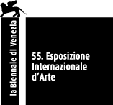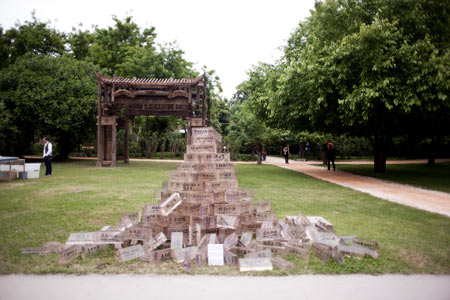ARTEXT : La Biennale di Venezia
55 Esposizione Internazionale d'Arte
Arsenale, Tese delle Vergini
TRANFIGURATION
He Yunchang, Hu Yaolin, Miao Xiaochun, Shu Yong,
Tong Hongsheng, Wang Qingsong,
Zhang Xiaotao
This year, the seven artists selected by Wang will seek to reveal the sophistication, maturity and diversity of contemporary art in China through their works. Facing the constraints of a particularly challenging space (the China Pavilion is a converted ship building warehouse filled with antique oil tanks, poor lighting, and limited space to exhibit), Wang's medium of choice for the Pavilion is video projection. With artistic backgrounds ranging from painting to video, photography and installation, the artists whose works have been selected for the China National Pavilion are He Yunchang, Hu Yaolin, Miao Xiaochun, Shu Yong, Tong Hongsheng, Wang Qingsong and Zhang Xiaotao.
Asked why Chinese Pavilion was named Transfiguration, Wang said the idea has its roots in The Transfiguration of the Commonplace, a book by American art critic Arthur Danto.
Trans?guration is an element in traditional, oriental thought. The Chinese translation is bianwei: the first character means change and the second represents the 64 hexagrams of the I Ching, he said. In the realm of art, change cannot
occur free of social influence. Since the Biennale emphasizes imagery, we have to be aware of what inspires its change. Wang strives to render the changes taking place throughout the history of Chinese art.
The 64 hexagrams are an artistic analog to how images can stem from the same origin but result in different outcomes.
Moreover, the root of transfiguration comes from the word figure, which also has to do with images: the prefix
trans-means to cross or to pass through. Consequently, I think transfiguration is the most proper theme for the Chinese Pavilion, Wang said. Wang's recent academic focus has been imagery.
In a broader sense, images refer to what you have seen. The patterns of ancient coins, attires of different Chinese dynasties or even social landscapes can be taken to be images, which are deeply related to visual depictions,she said. You can say that contemporary art serves as the embodiment of visual representation.
Among the seven male artists Wang has invited, two are extremely low-pro?le and hardly considered artists.
One is Hu Yaolin, who renovates ancient Chinese architecture, and the other Tong Hongsheng, a practicing Buddhist who sees painting as the path toward enlightenment. My selection of these artists also reflects the theme of transfiguration, as their identities are shifting, Wang said. Tong has zero interest in participating in the Chinese art world, not to mention to holding any solo shows or attending any opening ceremonies. But he is also a painter and an ascetic monk, he said. For Wang, Tong's hermit-like status is symbolic.
Even though the society is inclined to consumerism, I'd like to tell the audience that there are still people who believe in piety and lead a life with minimal material desires.
He chose Hu because of his contributions in protecting historic buildings. Hu bought or renovated many homes that were being demolished due to the government's policies. The urban landscape has radically changed since the
country began its rapid economic development, and many historic sites are unfortunately facing destruction, Wang said.
Hu has done a very good job of preserving these buildings. Major cities such as Shanghai and Wuhan have very few ancient buildings.
Even the countryside is rapidly losing its history, Wang said. If Hu didn't buy those historic homes, then visitors to the Biennale would have missed out on the chance to appreciate Chinese history, he said.
The other five artists are He Yunchang, Miao Xiaochun, Shu Yong, Wang Qingsong and Zhang Xiaotao.
Miao, Wang and Zhang are new media artists, while Shu is accomplished in several media, as well as performance. But even they are hardly celebrated in the Chinese artistic world. Exhibition halls are an appropriate place to display new media art, Wang said. I am trying to build a showcase of the diverse Chinese art world, which is not defined by those
who are famous or whose identities are limited to what they create in art.
Of course, seven people can hardly present the whole picture of Chinese art. The exhibition is just a symbol.
All in all, it's a small exhibition meant to capture the current social conditions in China, whether good or bad, Wang said. Wang expressed guarded scepticism about the boom in large art shows in China, such as Chengdu Biennale, Shanghai Biennale, Guangzhou Triennial and Xinjiang Biennale.
The first Venice Biennale was in 1895. In China, these exhibitions are designed to accelerate the economic progress of certain cities, he said. If the Chinese art world would like to have a prominent biennale, it's steady advancement that will matter.
Curatori : Wang Chunchen
Artisti : He Yunchang, Hu Yaolin, Miao Xiaochun, Shu Yong, Tong Hongsheng,
Wang Qingsong, Zhang Xiaotao.
Web site: http://www.labiennale.org |

